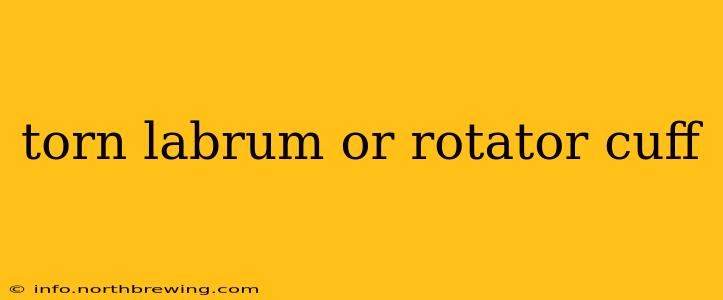Shoulder pain is a common complaint, often stemming from injuries to the labrum or rotator cuff. While both can cause significant discomfort and limitation, they are distinct injuries with different causes, symptoms, and treatments. This comprehensive guide will help you understand the key differences between a torn labrum and a rotator cuff tear.
What is a Torn Labrum?
The labrum is a ring of cartilage that surrounds the glenoid, the socket of your shoulder joint. It helps to deepen the socket, providing stability and cushioning for the ball of your humerus (upper arm bone). A torn labrum occurs when this cartilage is damaged, often due to a sudden injury like a fall or a forceful impact. It can also develop gradually over time due to repetitive overhead movements or instability in the shoulder joint.
Types of Labral Tears:
Labral tears are categorized in several ways, including:
- SLAP tears: Superior labrum anterior to posterior tears affect the upper part of the labrum, often involving the biceps tendon.
- Bankart lesions: These tears occur in the anterior (front) part of the labrum, often associated with shoulder dislocations.
- Posterior labral tears: These less common tears happen in the back of the labrum.
Symptoms of a Torn Labrum:
Symptoms can vary depending on the severity and location of the tear. Common symptoms include:
- Shoulder pain: This can range from mild aching to severe, sharp pain.
- Clicking or popping in the shoulder: This is often felt during movement.
- Shoulder instability: A feeling of the shoulder "giving way" or "slipping out."
- Limited range of motion: Difficulty raising your arm overhead or behind your back.
- Weakness: Reduced strength in the shoulder.
What is a Rotator Cuff Tear?
The rotator cuff is a group of four muscles and their tendons that surround the shoulder joint. These muscles help to stabilize the shoulder, allow for a wide range of motion, and assist with lifting and rotating the arm. A rotator cuff tear occurs when one or more of these tendons are damaged, usually due to overuse, aging, or trauma.
Types of Rotator Cuff Tears:
Rotator cuff tears are classified by their size and location:
- Partial-thickness tear: The tendon is only partially torn.
- Full-thickness tear: The tendon is completely torn.
- Small, medium, or large tear: Describes the size of the tear.
Symptoms of a Rotator Cuff Tear:
Symptoms of a rotator cuff tear often overlap with those of a labral tear, but some key differences exist:
- Shoulder pain: Pain can be felt in the front, side, or back of the shoulder, often worsening at night.
- Weakness: This is often a prominent symptom, making it difficult to lift or rotate the arm.
- Limited range of motion: Similar to a labral tear, but the specific limitations may differ.
- Atrophy: The muscles around the shoulder may waste away due to disuse.
Torn Labrum or Rotator Cuff: How Can I Tell the Difference?
Differentiating between a torn labrum and a rotator cuff tear requires a thorough physical examination by a medical professional. Imaging tests, such as an MRI or X-ray, are usually necessary to confirm the diagnosis and determine the extent of the damage. A doctor will consider your symptoms, medical history, and the results of these tests to arrive at a precise diagnosis.
How are Torn Labrums and Rotator Cuff Tears Treated?
Treatment for both conditions depends on the severity of the injury and the individual's activity level. Options include:
- Conservative Treatment: This involves rest, ice, physical therapy, and anti-inflammatory medications. This is often the first line of treatment for both conditions.
- Surgical Treatment: Surgery may be necessary for severe tears that don't respond to conservative treatment. Arthroscopic surgery is a minimally invasive technique often used for both labral and rotator cuff repairs.
Can you have both a torn labrum and a rotator cuff tear?
Yes, it is possible to have both a torn labrum and a rotator cuff tear simultaneously. This is because the labrum and rotator cuff work together to provide stability and function to the shoulder joint. A significant injury can affect both structures.
What are the long-term effects of a torn labrum or rotator cuff?
Without proper treatment, both conditions can lead to long-term shoulder pain, instability, and reduced range of motion. This can significantly impact daily activities and quality of life. Early diagnosis and treatment are crucial for optimal outcomes.
How long does it take to recover from a torn labrum or rotator cuff?
Recovery time varies greatly depending on the severity of the injury, the type of treatment received (conservative or surgical), and individual healing capacity. It can range from several weeks to several months.
This information is for general knowledge and does not constitute medical advice. Always consult with a healthcare professional for diagnosis and treatment of any shoulder pain or injury.
